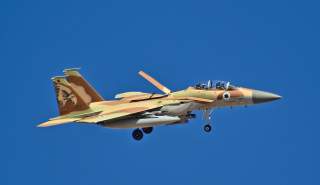Israel Has Its Very Own Version of the F-15 Strike Eagle
Could it be better than America's own F-15s?
One of the fighter jets most associated with Israel is the F-15 Eagle. The first F-15 touched down in Israel in 1976 and the jet has served continuously—and without defeat—since. In 1998, the Israeli Air Force introduced a new version of the jet, one designed for air-to-air and air-to-ground combat. The Ra’am (Thunder) serves as the long-range striking arm of the Israeli Air Force, complementing the new F-35I Adir fighter to ensure Israeli air superiority now and into the foreseeable future.
The earliest versions of the McDonnell Douglas (today Boeing) F-15 Eagle were pure air-to-air fighters. Large twin-engine, single-seat fighters, they featured a bubble canopy for excellent visibility, a powerful APG-63 radar, a combat load of four AIM-7 Sparrow radar-guided missiles and four AIM-9 Sidewinder infrared-guided missiles, and an M61 Gatling gun. The two Pratt & Whitney F100 engines gave the F-15 such an impressive power-to-weight ratio that the new jet could easily accelerate straight up.
The F-15 was large and versatile enough that engineers considered a multirole version, one that took advantage of the F-15’s power, range, and size to carry air-to-ground weapons. This led to the development of the F-15E Strike Eagle, which entered service with the U.S. Air Force in 1989 and promptly saw service in the 1991 Persian Gulf War.
The Strike Eagle’s performance in the Gulf War stirred Israeli interest. The Gulf War had not exactly gone as planned for Tel Aviv, which had been bombarded by Scud missiles launched by Iraqi dictator Saddam Hussein. Israel acquiesced to U.S. pressure not to retaliate, but even if it had decided to do so it lacked the long-range aircraft and reconnaissance assets necessary to hunt Scud launchers in Western Iraq. Saddam Hussein remained in power after the war to eject his army from Kuwait, ensuring that Iraq would remain a threat to Israel. Meanwhile, Iran was in the early stages of its nuclear weapons program. A long-range fighter would be a necessary weapon for deterring, or failing that destroying, threats from the east.
An Israeli Strike Eagle would go a long way toward fixing the Israeli Air Force’s shortcomings. The F-15E’s conformal fuel tanks would add range the range necessary to attack long-range targets. The dual air-to-air/air-to-ground capability meant an F-15E could self-escort if necessary. (In 1981, Israeli F-15s escorted F-16s tasked to destroy the Iraqi nuclear reactor at Osirak, enlarging the air group and the need for aerial refueling and other support.) A single plane that could do it all, that the Israel Air Force already knew very well, was an intriguing option.
Israel selected the F-15I, or Ra’am, in May 1994 with an initial agreement to buy twenty-one aircraft (known as Peace Fox V) with a further option for four more (Peace Fox VI.) The order was increased to twenty-five aircraft in 1995. The F-15 had already served in the Israeli Air Force for fifteen years, and Israeli engineers had plenty of ideas on how to improve on the platform. Israeli Aerospace Industries worked with manufacturer Boeing (which had since purchased McDonnell Douglas) to contribute many of the aircraft’s avionics.
The F-15I hosted a number of indigenous features. The aircraft had an Israeli-made central computer, GPS/inertial guidance system, and an Elbit display and sight helmet (DASH). The airplanes were delivered with electronic warfare systems built into the F-15E, instead of using the Israeli Elisra SPS-2110 Integrated Electronic Warfare System.
The F-15I could carry all the weapons Israeli F-15As carried and then some. The Ra’am initially carried AIM-9L Sidewinder and Python infrared-guided short-range missiles, but time has narrowed that down to the Python. The fighter also carried both the older AIM-7 Sparrow and newer AIM-120 AMRAAM radar-guided medium-range missile.
The F-15I’s twin engines and large airframe mean can carry up to 18,000 pounds of fuel and munitions. The Israeli Air Force originally described the jet’s ordnance load as thirty-six Rockeye cluster bombs or six Maverick air-to-ground missiles. Today, the F-15I’s air-to-ground munitions set has expanded to include Paveway laser-guided bombs, Joint Direct Attack Munition (JDAM) satellite-guided bombs, BLU-109 “bunker-buster” bombs, the SPICE precision-guided bomb, and AGM-88 HARM anti-radar missiles.
The first F-15I arrived in Israel in 1997, with new aircraft arriving at about once a month until the order was fulfilled in 1999. The aircraft served continuously over the past twenty years, not only in training exercises but anti-terrorism operations, the 2006 Lebanon War, the Gaza War, Operation Pillar of Defense, and Operation Cast Lead. The F-15Is were also heavily involved in Israeli planning to strike Iranian nuclear facilities had Iran, a strike headed off by the signing of the 2015 nuclear agreement between Iran and the West.
The IAF’s adoption of the F-35I “Adir” fighter did not dampen the country’s enthusiasm for the F-15. The IAF still calls the aircraft its “strategic aircraft,” with the head of the Air Force stating, “At the end of the day, when we want to reach far distances with few aircraft many arms - the F-15I wins.”
In 2016, Israel announced the start of an upgrade program meant to keep the F-15I relevant, including a new active, electronically-scanned array radar and updated avionics. In 2018, the IAF was reportedly torn between purchasing F-15I and F-35 fighters, leaning towards the former over the latter. If Israel purchases more F-15s, it will almost certainly end up flying the platform for the better part of a century. That’s a ringing endorsement for a warplane first flown in the early 1970s.
Kyle Mizokami is a writer based in San Francisco who has appeared in The Diplomat, Foreign Policy, War is Boring and The Daily Beast. In 2009 he co-founded the defense and security blog Japan Security Watch.
Image: Flickr.

